Hell is Empty by Craig Johnson [Book]

view/request


view/request

view/request
This film celebrates the musical collaborations of Jerry Garcia and David Grisman. The film, by David’s daughter Gillian, is an affectionate tribute to the music created when these two musical giants worked together. Garcia and Grisman shared a common enthusiasm for bluegrass and American roots music, but Grisman had a tight and disciplined approach to the music, while Garcia was well known for his relaxed attitude. Something special happened when they worked together, as Grisman loosened up, Garcia became more focused, and each took on some of the best qualities of the other.
This film isn’t particularly rich in storytelling, and it is nothing special to look at, but it contains some good interviews with Grisman, Garcia, and their many collaborators, including Vassar Clements and Peter Rowan of Old and in the Way. The real focus of the film, however, is the music, and the camaraderie between these great musicians, and that is how it should be. The film’s editors often made the unfortunate decision to show footage, often in slow motion, which doesn’t match the music being played, but this is easy to over look. All you have to do is close your eyes and listen—and listening to these two play together is a joy.
Tagged: Bluegrass, Documentary, Folk music

view/request
Albert Finney stars in one the last films by the prolific American director, John Huston. Under the Volcano is based on the semi-autobiographical novel by Malcolm Lowry.
Delusions and alcoholism are the central themes of this film. We join Finney’s character, Geoffrey Firmin, just after the Day of Dead fiesta in Mexico in 1939. Firmin, who is an alcoholic and bitter English consul, wanders throughout a beautiful Mexican village with his life spiraling out of control. Though he tries to pull himself together when his estranged wife (played by Jacqueline Bisset) stops for a visit, moments of clarity and decent behavior are few and far between.
Finney’s portrayal of this troubled character would most likely be over the top handled by another actor. He manages to create someone loud and belligerent, pitiful and charming on some occasions. We want him to dig himself out of this self-inflicted crisis, but we understand that he’s incapable. Huston paints this personal drama with the beauty of the Mexican village and also a strange wallpaper of supporting characters (including the director/writer/actor Emilio Fernández).
This Criterion Collection dvd has a painstakingly assembled bonus disc that profiles John Huston, provides behind the scenes footage and includes the film Volcano: An Inquiry into the Life and Death of Malcolm Lowry (narrated by the late Richard Burton).
Tagged: Alcoholism, Drama

view/request
This album marries two of my favorite genres of music: specifically, 16th century Renaissance dances and British folk-rock of the 1960s and ’70s.
Richard Thompson and some ex-Fairport Convention comrades joined conductor and multi-instrumentalist Philip Pickett (who has Albion Band credentials as well as early music) in 1998 to rock out on a selection of tunes by William Byrd’s contemporaries. When I used to play electric harpsichord for English Country Dancing back in the early ’90s, this was the sort of sound I dreamed of achieving. Imagine a note-perfect recorder consort accompanied by Dave Mattacks on drums, or dueling krumhorn and electric guitar, or virginal with a very electrified bass continuo. The tunes are brilliantly arranged, irresistibly driving, reverently irreverent (or vice versa), passionately fun and absolutely classic in every sense of the word. Turn it up, way up.
Tagged: Early music, Rock music
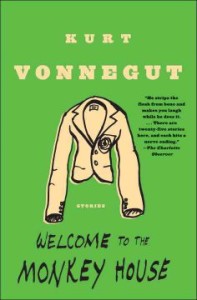
view/request
Selections from Kurt Vonnegut Jr.’s Welcome to the Monkey House, an anthology of shorter fiction, appeared on the Showtime channel in the early 1990’s. The series was on the air for a brief time, but all of the episodes exist on a dvd that we’ve just received from the Pleasant St. Video collection.
Welcome to the Monkey House is fascinating from the outset; the author makes an on camera introduction to the episodes. His opening dialog is the only instance of seeing him on film/tape that I can recall (until this moment, I’ve used my imagination to estimate his mannerisms via book jacket photographs!).
The stories and the overall feel of the series strike a kinship with David Lynch and Mark Frost’s Twin Peaks. Both idiosyncratic television programs were on the air around the same time, draw from 1950’s style and also deal with the abnormal. A mysterious double life, a sadistic battle of wits involving humans as chess pieces, a woman’s obsession with home design catalogs and a child’s eventful night without a babysitter all feature in Welcome to the Monkey House.
Vonnegut has always struck me as someone who has the ability of skillfully introducing science fiction elements or ideas into his writing without having them seem far removed from contemporary society. Though he often delves into the world of science fiction, I can’t classify him solely as a science fiction writer. His laconic central characters tend to ease us into strange, new worlds by having a dark sense of humor or an overall surly, sarcastic attitude toward the present state. For instance, a soap opera actor portraying a doctor is lead into mansion that houses an elderly woman whose only original body part is her head. The actor is initially surprised, but accepts the situation within moments after the orchestrator of this scientific achievement gives his explanation in the most blasé fashion possible.
Kurt Vonnegut’s stories are wonderfully captured in this series and feature performances by Madeline Kahn, Frank Langella, Jon Cryer and many more fine character actors. It was a short lived television program, but it managed to capture some of the author’s bizarrely brilliant concepts.
Tagged: Drama, Fiction, Humor, Science fiction
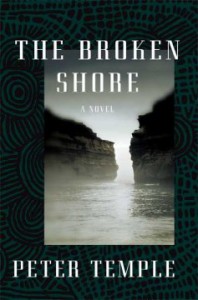
view/request
Joe Cashin is a big city cop who has gone back to his childhood home on the coast of South Australia to recuperate, physically and mentally. When a local millionaire is murdered, Cashin won’t accept the easy story that some local aboriginal boys are responsible. In the course of the investigation, Australian political and social divisions are examined. The sense of place is practically another character, but be warned: this is a darker Australia than is often portrayed in the media. Includes helpful Glossary of Australian Terms. Temple is the winner of five Ned Kelly Awards by the Crime Writers’ Association of Australia.

view/request
I love Eddie Izzard’s stand-up. In Glorious he lopes across the stage imitating an evil giraffe, he runs in mock fright exclaiming, “I’m covered in bees!”, and he delivers a stream of unconventional witticisms, comical sound effects, and insightful observations.
Eddie’s jokes are carefully written but his delivery is casual and off the cuff. His jokes often rely on gesture and facial expressions, never more so than in his routine on “machines that lie”, during which he mimes the frustrations of making good toast and demonstrates the visual similarity between someone adjusting the tap in a shower and a safebreaker. (He ends this routine with a wonderful visual pun which I will refrain from describing—you will appreciate it better if it takes you by surprise.)
I don’t care much for stand-up, but I make an exception for Izzard’s smart, irreverent, performances. His shows are always entertaining andGlorious is one of his best.
Tagged: Comedy
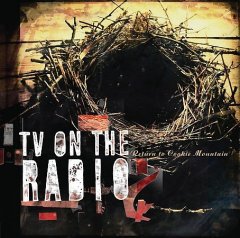
view/request
Return To Cookie Mountain (2006), by the Brooklyn-based quintet TV On The Radio, was my introduction to this group’s music and I quickly became a fan. I really enjoy the unique harmonies and vocal layerings of the two primary vocalists Tunde Adebimpe and Kyp Malone. The melodies are also exceptional and have been described as “atmospheric” and “spacious” Their music is not easy to categorize but some close approximations include: indie-rock, soul and trip-hop. Repeated listenings to this CD always reveal more pleasurable discoveries of their unique sound. Two outstanding tracks for me are “I Was A Lover” and “A Method”.
Tagged: Indie rock, Rock music
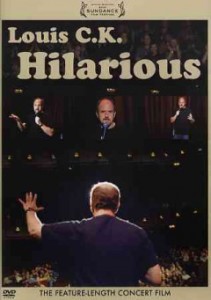
view/request
Tagged: Cell phones, Comedy, Divorce, Fatherhood, Obscenity, Parenting, Stupidity
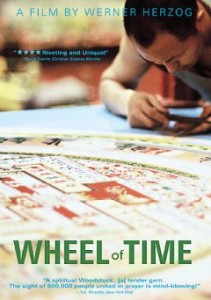
view/request
Werner Herzog, director of Fitzcarraldo, Aguirre: the Wrath of God and Stroszek, has almost become equally as famous for his non-fiction work in recent years thanks to the success of the fabulous Grizzly Man documentary. Forbes Library is fortunate to be receiving several of Herzog’s documentaries (many of which currently hard to find, out of print titles) through our acquisition of the Pleasant St. Video collection thanks to the kind donations from our patrons.
I first saw Wheel of Time at a Werner Herzog retrospective in Austin, TX. I must confess that I didn’t know much about the film or this German auteur at the time. I would soon receive a wonderful education by purchasing a pass to attend the rest of the festival and also borrowing everything I could find by the director at the video library where I was then employed.
The film chronicles a Buddhist pilgrimage to Bodh Gaya, India. At this destination, several artists create a giant, yet intricate, sand design or “sand mandala” (which is referred to as the wheel of time). The creation of the sand mandala is carefully constructed over a lengthy period of time and the viewer is constantly worried that it will not be completed by its deadline (or at least I was feeling tense). The stunning landscape along our travelers’ journey and the vibrant colors of the dyed sand are brilliantly captured by the film’s gorgeous cinematography. There is also a personal interview Herzog conducts with the Dalai Lama.
Wheel of Time, along with many of his documentaries, is certainly as interesting and entertaining as his classic fiction films. In both mediums, we are often supplied with adventure, drama, social commentary, humor and taken to exotic locales. Whether going up in a strange flying apparatus into a rainforest canopy, living in the jungle while filming, hauling a riverboat up a mountain, eating his own shoe, working with wild bears and collaborating with Klaus Kinski (!), Werner Herzog has managed to survive and also produce great art. It wasn’t until a 2006 BBC interview when his life became (arguably) most in danger when a sniper opened fire with an air rifle. After the shooting Herzog calmly commented, “it was not a significant bullet. I am not afraid.”
Tagged: Buddhism, Documentary, International
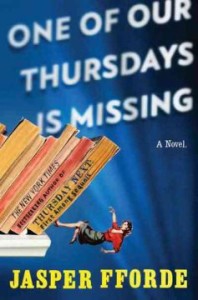
view/request
Jasper Fforde’s latest offering in the Thursday Next series is a metafictional tour de farce. The original Thursday — literary police Special Operations Agent (ret.) and the star of her own series of novels-with-novels — has disappeared, and it’s up to her fictional character to find her by impersonating the real Thursday. There’s a border dispute in BookWorld between the genres of Racy Novel and Women’s Fiction, and if Thursday doesn’t show up for the peace talks, war might ensue. Fforde sprinkles his story with characters and allusions from the classics and popular fiction, and makes liberal use of puns including setting up whole subplots just for a punch line. His style is uncategorizable and nearly indescribable, at least not in a way that makes any sense, but irresistibly entertaining and uniquely inventive. This sequel refers back to things that happened (or didn’t) in previous titles in the series, and it might help to start with the first installment, The Eyre Affair.
Tagged: Fantasy, Fiction, Humor, Literary fiction
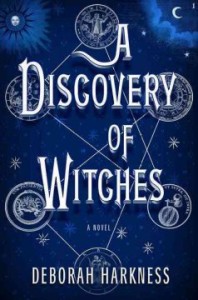
view/request
Tagged: Fantasy, Fiction, Paranormal